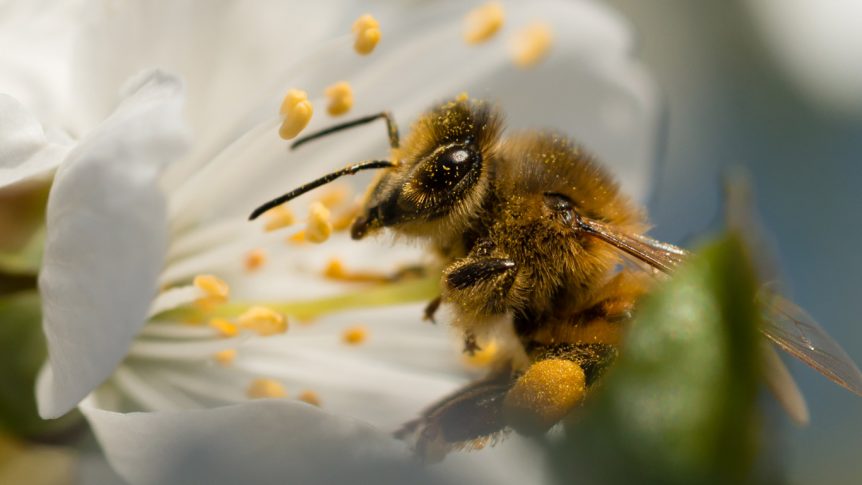The plight of the bees has been a growing concern for everyone who eats. While there are multiple theories on what has caused bee population decimating Colony Collapse Disorder, having inadequate foraging territory and poor nutrition are potential causes every home gardener can help fight. Creating pollinator gardens or even just adding pollinator friendly plants to landscaping or in the vegetable garden can help keep things buzzing along.
“While it’s been said if bees vanish from the earth we would only live for 4 years, that’s a very questionable assumption and, hopefully, an event society will not have to face,” says David Trinklein, University of Missouri extension horticulturist. “What is true is they’re responsible for about a third of the food we eat. If they vanish we wouldn’t starve, but they’re still a very important part of our food chain.”
Pollinators as a whole are necessary for a huge amount of food production, but the European honey bee is a critical species.
“They’re the king of the pollinators,” Trinklein says. “They are morphologically designed to be pollinators while other species are more accidental pollinators. They’re also greater in number and activity level than other species of pollinators.”
Whether doing your part to help support this critical part of the ecosystem or just because you enjoy watching them at work, here are some ways to make your garden and landscaping an inviting and nourishing place for bees.
1. Nectar and pollen. Bees need both nectar and pollen to survive. Nectar is used to make honey, which is a carbohydrate bees consume for quick energy. But careful observers of European honeybees will notice they have pollen-collecting sacks on their hind legs. The pollen is taken back to the hive and transformed to what is known as bee bread. As opposed to the quick, simple energy of honey, bee bread provides protein, fats, minerals, and vitamins. It’s a critical foodstuff especially for the youngest members of the hive making it critical for hives to continue to grow and prosper.
“Many flowers produce both nectar and pollen, but fragrance is a great indicator of a good nectar producer. Nectar and fragrance go together,” Trinklein says. He notes it’s not just good odors that will be attractive to bees. “The butterfly bush is great for attracting bees but, to me, it doesn’t have an appealing smell. However, it produces nectar as is evident because of its attractiveness to pollinators. If we are trying to attract pollinators we can’t rule out plants that aren’t on our olfactory top 10 list.”
Easy to grow and a treat for the nose, members of the mint family are honeybee magnets, Trinklein says. A number of herbs, including basil, thyme, lavender, lemon balm, oregano, marjoram, rosemary, sage, are all of the mint (Lamiaceae) family. In fact, a gardener may choose to plant a scent garden subsisting entirely of herbs for the enjoyment of the gardener and the bees. Check out this article for tips on gardening with scent.
2. Keep it warm. Bees need warmth to work. They can’t even fly if temperatures are below 55F and won’t be out and working until the thermometer hits 57F.
“The sooner the sun strikes the garden in the morning, the sooner the bees will be warm and start to become active,” Trinklein says.
3. Provide protection. Wind can be problematic for bees as it can make accurate flight difficult and disperses the fragrance attracting them to their food source. “Having the garden somewhat sheltered from wind will make it easier for the bees to fly and also make the garden more enjoyable for the gardener. The fragrance of the nectar will linger and there will be more bee activity to observe,” Trinklein says.
A windbreak of shrubs, trees, or a building can help counter the wind. Be sure to position the garden so these wind blocking structures will cast shade on the flowers in the afternoon when temperatures are already warm. While they need heat to get going, bees don’t like to be overly hot, either, and will stop working when temperatures exceed 100F. A little afternoon shade can give them more hours to collect vital nectar and pollen.
4. Continuous bloom. Bees need to collect food from early spring through late fall to support a healthy hive. To be a full-season host for honeybees, it’s critical to always have food available to them which means planting a variety of flowers.
“In perennial borders you’ll want to make sure you have something that’s attractive to pollinators blooming early, mid, and late season,” Trinklein says. Columbines are one of the first flowers of spring, but stop blooming once truly warm weather hits. But with diversity in the garden, the bees can move from columbines to a warm weather loving bloom like black eyed susan. For tips on keeping a garden in constant bloom, visit this article to achieve a Continuous Cascade of Color .
5. Shelve certain pesticides. If there’s an undesirable insect munching on flowers, carefully choose the means for controlling them. Some pesticides will also be detrimental to bees. An insecticidal soap may be a better option for controlling pests like aphids.
“Bees are covered with pubescence, or hair,” Trinklein explains. “Detergents will dry out and crack the exoskeletons of many soft-bodied insects but is relatively harmless to bees because of these hairs.”
With a bee friendly garden, look forward to working side by side with these industrious and essential insects. Generally unless they’re accidently crushed or swatted, bees will go about their business and leave the gardener to theirs. However it is advisable to avoid strong smelling perfumes, hairsprays or other fragrances which might attract to the gardener confused bees seeking out nectar.
Helpful links:

